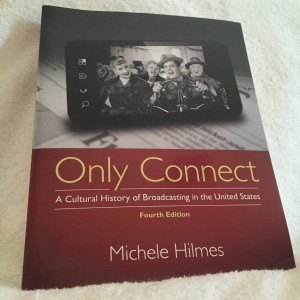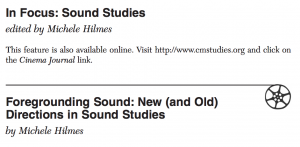A Voice Made for Radio Studies: Michele Hilmes and the Building of a Discipline
 This is the first post in a series titled “Honoring Hilmes” that will run here on Antenna over the next couple weeks. In these posts, various colleagues, students, and friends will be paying tribute to the career and legacy of Michele Hilmes, who is retiring from the University of Wisconsin-Madison at the end of this Spring semester. – Andrew Bottomley, Antenna Managing Editor
This is the first post in a series titled “Honoring Hilmes” that will run here on Antenna over the next couple weeks. In these posts, various colleagues, students, and friends will be paying tribute to the career and legacy of Michele Hilmes, who is retiring from the University of Wisconsin-Madison at the end of this Spring semester. – Andrew Bottomley, Antenna Managing Editor
Post by Bill Kirkpatrick, Denison University
Here’s an under-appreciated fact: Michele Hilmes is a talented singer, as in “sings in public and people want to listen” talented.
I mention that because the many encomia to Hilmes in the wake of her retirement from teaching are likely to focus on her academic accomplishments, so it’s nice to inject some tidbits about the person. But the real reason is because the metaphor of the voice is just too irresistible when discussing the leading figure in Radio Studies of the past two decades: she is someone who gave voice to the discipline, who championed its many voicings. In that way, Hilmes’ voice and legacy resound far beyond her own work, and well beyond Radio Studies itself.
Donald Hambrick and Ming-Jer Chen argue that successful new academic disciplines emerge when scholars build “admittance-seeking social movements.” In contrast to Kuhnian revolutions or divisive confrontations with the disciplinary mainstream, the admittance-seeking movement seeks to carve out a place for new scholarship within an existing area of study. A major part of Hilmes’ importance has been her success in persuading Media and Cultural Studies to recognize the value of Radio Studies and Sound Studies in the face of its original indifference or even resistance.
For an admittance-seeking movement to thrive, say Hambrick and Chen, three elements are needed: differentiation, mobilization, and legitimacy-building. First, “it needs to differentiate itself from other existing fields, making claims about how a class of important problems cannot be solved by these status quo entities.” Hilmes, as a cultural historian who thinks as much about media institutions, economics, and policy as she does about the social, cultural, and political roles of texts, has been able to make a strong case for differentiation, showing her colleagues how the study of radio contributes to important questions in the field.
She makes the case for radio scholarship along multiple axes: the interconnectedness of radio and film, the indebtedness of television practices and texts to radio’s precedents, the centrality of radio to questions of cultural politics and the public sphere, the transmedial problem of sound, and many more. The breadth of her work reflects, first and foremost, an extraordinarily creative mind that can’t help but identify interesting connections; along the way, however, and as a byproduct of that breadth, Hilmes brings radio studies into a range of other conversations, allowing scholars of film, television, policy, gender, nationalism, and many other subjects to see the significance of radio to the questions they are interested in.

Only Connect, Fourth Edition (Cengage Learning, 2013)
The second of Hambrick and Chen’s elements is the mobilization of resources, by which they mean building the infrastructure and social relationships that enable like-minded scholars to find and support each other, define the questions and objects of the field, share their work, and form a disciplinary identity. In this regard, it is no surprise that Hilmes was so drawn to E. M. Forster’s phrase “only connect” that she named a book after it (Only Connect: A Cultural History of Broadcasting in the United States). She’s a connector of the first order; for example, approaching her at a conference is always tantamount to getting an introduction to someone else in the field. Among radio scholars, her generous mentoring and tireless encouragement of junior scholars is, without exaggeration, legendary.
But beyond being supportive at an interpersonal level, Hilmes has accomplished a lot of concrete, practical field-building for Radio Studies. Among the initiatives that owe a substantial portion of their success to Michele include the biannual Transnational Radio Conference, Radio Journal, the North American Radio Studies Network, and the expansion of Sound Studies within the Society for Cinema and Media Studies (SCMS). These initiatives brought together radio researchers from around the globe and helped them see themselves engaged in a common scholarly enterprise.
Teaching is equally critical to sustaining a discipline, and Hilmes contributed there, too: recognizing that we needed a textbook that did justice to radio within the history of broadcasting, and that she was in a position to write one, she did. She even deserves credit for some things that I’m happy to put on my own CV, like co-founding the SCMS Radio Studies Scholarly Interest Group with Alex Russo: that was basically Michele’s idea. In other words, if Radio Studies is more vibrant than ever, it is because Hilmes, not alone but foremost, has mobilized resources and organized people in order to establish the enabling conditions for the field to emerge and expand.

“In Focus: Sound Studies” from Cinema Journal 48.1, Fall 2008; edited by Michele Hilmes.
Hambrick and Chen’s third element in field-building is: the new discipline must be taken seriously: “[T]he aspiring community must build legitimacy in the eyes of the academic establishment, by intellectual persuasion.” Hilmes’ work speaks for itself, of course, as does the legitimacy of radio scholarship through the Hilmesian work of her graduate students, colleagues, and respected scholars across Media and Cultural Studies. But she has also engaged in more active persuading: by editing an “In Focus” on Sound Studies in Cinema Journal, making the case for Radio Studies in a range of venues as keynote speaker or invited panelist, or simply asking the “What about radio?” question as an audience member at conferences.
If the above reads as overly biographical, so simply overly fannish, I hope it nonetheless also illustrates for scholars in emerging fields what it takes to build and give voice to a discipline. Hilmes’ example shows that great scholarship is important, but it is not enough: new areas of study emerge primarily through the concrete labor, so different from the research we’re trained in, of making the case for new kinds of scholarship and organizing the people and resources to give it wings. Because she has been a great scholar and done that kind of work, Michele Hilmes can be assured that her legacy is not just on the library shelf; it is reflected in the journals, the listservs, the conferences, and above all the people who, collectively, are Radio Studies.



[…] off the series, Bill Kirkpatrick emphasized Michele’s role in “giving voice” to the discipline of …. He writes that a “major part of Hilmes’ importance has been her success in persuading […]